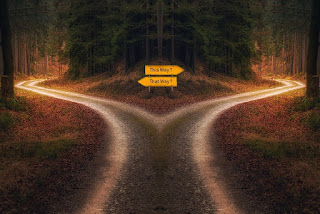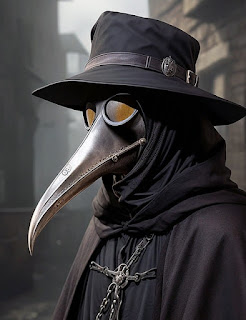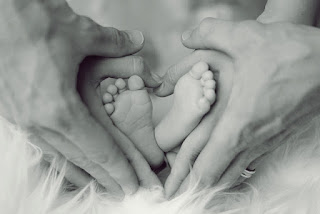To this point, I've done my research using the hop, skip and jump method. I surfed from person to person attaching mostly the "easier" hints. Sure, I did plenty of census records and obits (both take me a long time to mine all the details). Generally speaking, working this way allowed me to keep all 4 branches of my tree growing. But now, I'm at a point where I need to buckle down and tackle one person at a time. I'm spending too much time clicking next page...next page...looking for the easiest hints. Most of the records I'm skimming through are going to take longer, as they contain more details and typically more people. I have to be in a different mindset to buckle down and tackle the hints I know will take longer. So, I'm changing up how I work entirely.
Honoring those memorialized in family trees everywhere...and the ones yet to be discovered. Sharing inspiration, information & opinions for the journey finding family.
30 September 2023
My New Research Plan
22 September 2023
Plague Doctors and Pandemics
Imagine when there was no social media, no internet, no tv, no radio, and few printed/written materials. Word of mouth depended on someone living long enough to pass information along to the next person. We're fortunate to live in a time when we benefit from advancements in medicine. Ongoing research, vaccines and the simple ability to communicate quickly to the masses are all critical to stemming the death toll. But just like our ancestors, we would all be wise to understand nature is still stronger and smarter than us. We will always be at least a step behind. Viruses, bacteria and the smallest living organisms will continue to morph and evolve and new threats will always be on the horizon. The most we can hope for is to learn from the past, and keep our eyes on the future.
Image by Sabrina Belle from Pixabay
17 September 2023
Daddy's Ditties
My dad used to grin like a Cheshire Cat and chuckle after he'd say any of these. Clearly, he repeated them enough times they stuck with me all these years. Do you have any little ditties your family shared? And do you share them with the next generation?
If you're squeamish, skip the last one!
Before I knew biology, the dangers of a kiss.
I thought that kissing you was the nearest thing to bliss.
But now I know biology and I just sit and moan.
10 million mad bacteria and I thought we were alone.
The mule he has two legs behind, and two he has before.
You get behind, before you find, what the two behind be for.
Johnny was a chemist.
But Johnny is no more.
For what he thought was H2O,
Was H2SO4.
One bright day in the middle of the night,
Two dead boys got up to fight.
Back to back they faced each other,
Turned around and shot each other.
Repeat after me:
"Whatta"
"Goo"
"Siam"
Now put it all together:
"What a goose I am. "
STOP HERE IF YOU'RE SQUEAMISH!
My bonnie has tuberculosis,
My bonnie has only one lung.
She coughs up big yellow oysters,
And wallows them over her tongue.
Image by Andrys Stienstra from Pixabay
13 September 2023
Effortlessly Working with PDFs
I prefer the PDF Candy Chrome Extension but you can also go directly to the website at PDFCandy.com. This site allows you to convert 20+ file formats to and from PDF, compress, edit in numerous ways, merge, split, even extract text and/or images. The only drawback is the tools are all individual and not in any particular order, so you may have to scroll to find the one you need, but the site interface is simple and straightforward. Resulting files in the free version are available to download for 120 minutes with no login/signup required. The one caveat is you can only perform 1 task per hour for free. If you need to do more than one task, to keep it free, you'll have to return to the site a few times or use multiple browsers to get around the limit. But if you're like me, the need is occasional (such as combining multiple PDFs into a single file, or converting a PDF to JPG) and one task may be all you need to accomplish your goal.
If you're a power user, there are pricing plans as low as $6/month cancel anytime, $4/month if you sign up for a full year, or $99 for a lifetime license. If you find you need to do a lot of editing at once, but only for a limited time, $6 is a bargain and then you can cancel. If you work with files on the regular, the lifetime price is less than just a few months at other sites.
Next time you need to work with PDF files, give PDFCandy.com a try!
Image by Ulrike Leone from Pixabay
08 September 2023
All the Unknown Babies
Babies are such precious little bundles of joy. I'm always terribly saddened when I'm working on census records or obituaries and find clues to children who presumably died as infants or young children. I make it a point to add every unknown child to my tree, even when I know I'll likely never find any further information on them. I believe they deserve to be remembered.
Times were different in centuries past There was a much higher incidence of infant mortality. In the 1800's the infant mortality rate for children under 5 years of age was as high as 46%. That's almost 1/2 of all children born! By the 1900's this was down to about 25%. Today, thankfully, it's less than 1%. Before good recordkeeping on births and deaths, many of these tiny souls were never recorded. They may have been unnamed if they died at, or within a few days of, birth. While many were likely buried, it can be difficult to locate where. If there is a headstone, it may simply say "infant" or "baby". It may be impossible to determine if the child was a boy or a girl. Too many of these precious angels have long been forgotten.
Before the 1900's it may be difficult, or even impossible, to ascertain how many children a given family may have lost. I've been lucky enough to find well kept church parish records from the 1800's in England on baptisms and burials, shedding light on some children in my tree. Thankfully, the 1900 and 1910 census gives us a glimpse of some these innocent souls. The questions about how many children were born to a mother, and how many children were still living as of the record date may help identify those who passed away too soon. Especially if you've done detailed analysis of the children who lived to adulthood, you'll likely be able to work out how many unidentified children there may be, or potentially determine if a child previously enumerated passed away in the decade between the censuses. Sometimes family histories written at the time will say how many children were born, but only name those who survived. Occasionally, an obituary of a parent or sibling might reference the death of a child, but often they go unmentioned. There are rare occasions where I've found an obituary for an infant or very young child, but it's the exception.
I also marvel at how the parents of these children carried on. I can't imagine the horrible pain of losing one child, let alone the families who lost several. In one case, I read about a family who lost all their children to illnesses within a very short span of time. The pain those parents felt must have been immense. But, since many likely had other children to take care of, they had to carry on. I wonder how often they thought of the children they lost? Did they lock the painful memories away in a corner of their heart? Did they remember them everyday? Or possibly, in a time when the death of children was tragically almost commonplace, was the outlook simply different? Was it just one less mouth to feed? Whatever the case, I choose to memorialize the children who died young, never having had the chance to live their lives. They are not forgotten.
Image by Andreas Wohlfahrt from Pixabay
06 September 2023
Liking Linkclump
Simply drag and draw a box (shown in red in the image) using the left mouse key + Z around the links you want to open and Linkclump does all the clicky work, opening them all at once in new windows or tabs (depending on how you set it up). I changed my action key to be "Ctrl" instead of "Z" because I can remember it easier. Customizing is super simple.
I use it to open all the Ancestry.com Suggested Records (and I haven't encountered any issues no matter how many links I've selected), then I click thru them and close the ones I already have saved. Anything remaining I either review on the spot or copy the URL for future research. I've learned from experience, just because something shows in your new hints today doesn't mean it will be there tomorrow. It's best to save any URLs you may want to research later using whatever system works best for you. I use iDailyDiary by Splinterware as detailed in my previous post.
03 September 2023
In the Palm of My Hand
Today, I went through my mom's hope chest (a sacred place I was never allowed to snoop as a child) as we continued cleaning out my childhood home. I noticed a small, unassuming white box. As I removed the lid, I discovered half a dozen old coins. While they were all 75+ years old, one caught my eye. It's an 1821 Capped Bust Half Dollar.
It has significant toning, or we can just call it what it is - tarnish (which I understand is best left alone so the coin isn't damaged. Apparently, natural toning is desirable to collectors.) But this coin will not be sold - it will be treasured for at least the next generation, and hopefully beyond. My maternal grandfather collected coins, and I suspect it was one of his, but I will never really be sure where it came from or how it ended up in the hope chest.
02 September 2023
Family History Daily Course Center
I'm not a professional genealogist (far from it) - I'd call myself an intermediate amateur (and when it comes to analyzing DNA, a definite beginner). When I first started building my family tree, I made a LOT of mistakes. Even after restarting my tree several times over the years, I continued to fall into the same bad habits and patterns. I can't count number of blogs and articles I've read cautioning not to blindly trust other people's trees. Do the research yourself! Don't just accept hints, make sure they make sense for the person you're working on. Nonetheless, I barreled through dozens of hints a night, hundreds in a weekend, measuring my progress by the drop in hint count and increase in number of people in my tree. And I realized - my tree was a MESS! How could I ever fix it? The thought of trying to "clean it up" was beyond daunting. I finally accepted, I needed to start over, from scratch.
Before I jumped into my do-over, I spent time researching affordable genealogy courses. I knew I needed to reframe my thinking and improve my skills. I didn't want to spend thousands of dollars or years in classes. I didn't have time for scheduled online classes. I wasn't after a certificate or degree. I didn't want to be a professional genealogist. I wanted a decent, easy to understand, useful course, at a reasonable price and to study at my own pace. Enter Family History Daily Course Center.
Family History Daily has tons of articles, tips/tricks and guides anyone can access for free. There's quite a lot of valuable information to be had in the free resources. But for those who crave more, they also offer the Family History Daily Course Center with several courses to choose from to fit almost any budget and goal. Courses are online, easy to understand, self paced, created by experts. Prices range from $89 (for the Ancestry.com Crash Course) to $339 (for the Complete Access Package, including access to any new courses offered in the future). I decided the Complete Access Package was the right choice for me. After registration and payment, access to the courses is immediate.
Courses include lessons, hands-on activities, quizzes, forms, charts, worksheets and links to valuable research resources. I completed all the courses in my package, and felt much more confident as I set out to restart my tree (for what I've pledged is the final time). While the number of little green leaf hints still makes me anxious sometimes, I now take my time adding people to my tree. I've learned to verify and cross-check information before adding facts and saving records. My organization and search skills have improved dramatically. I scrounge every little scrap of information (no matter how small) from each record because you never know how important one little detail might be or what door it might open when researching in the future. I no longer wonder how/why I added someone to my tree. In short, I'm proud and confident in my tree.
If you're considering taking a course to improve your research skills and genealogy knowledge, I highly recommend the Family History Daily Course Center. Genealogy is a big investment in time and effort (and for some, money). Continually improving your skills and bolstering your knowledge will help you make the most of your genealogy journey.










